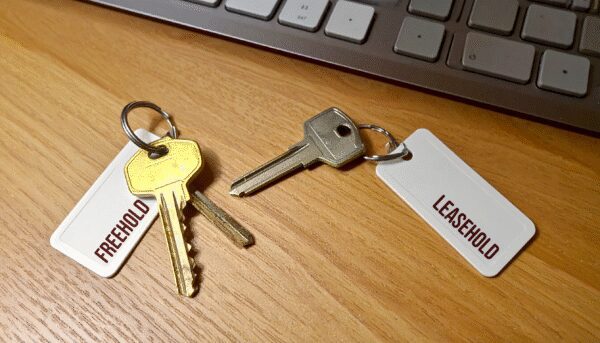Latest Posts

Why is there Leasehold Property Ownership? What Buyers Need to Know
When purchasing property in England and Wales, there is a clear distinction between properties being held on a leasehold basis as opposed to being held as freehold property. Leasehold property ownership derives from an historical feudal system, that has been phased out in many parts of the world, but remains a common way of owning property in England and Wales. Nearly every apartment in England and Wales is held on a leasehold basis. It is no wonder then that leasehold ownership has has a spotlight shone on it in the recent years, and is part of the UK government’s legal reforms to change some of the legislations surrounding property ownership.
Leasehold vs Freehold Property
Firstly, we set out the key features for freehold property:
- The property includes the land that it sits on, and is owned for an infinite time.
- No ground rent is payable, although for some freehold houses there may be an estate charge payable as a contribution towards estate management costs.
- The owner is responsible for the maintenance of the building, this includes the structures, roof and the foundations. It is entirely their property.
- Flexibility for alterations to be made to the building, subject to local planning laws and building regulations.
The key features for leasehold property include:
- Leasehold interest means that you hold the property for a fixed term, commonly the lease terms granted would be for 99, 125, 250 or 999 years from the lease commencement date.
- Ownership will be held under a lease whereby the freehold owner (the owner of the building) will be known as the Landlord or Lessor, and the leasehold (the property owner) will be known as the Tenant or Lessee.
- Annual ground is payable to the Landlord under leases granted prior to the Leasehold Reform (Ground Rent) Act 2022 coming into effect. Levels of ground rent can differ from property to property.
- Service charges are payable to the Landlord or an appointed management agent as a contribution towards the maintenance and repairs of the building and estate, and building insurance.
- Restrictions within the lease govern the leasehold owner’s rights and use of the property, including the terms on which the property can be let out, how the ownership can be transferred or sold, how common parts are managed and insured by the freehold owner, what alterations may be restricted.
Practical considerations for Buyers purchasing leasehold property
The remaining term of the lease is one of the most important considerations when purchasing leasehold property. The number of years remaining will affect the marketability and value of the property, some lenders will not consider the property as good security should the remaining term be below a certain number of years. The extension of lease terms is a niche area of property law and such rights and processes have typically been costly for a leasehold owner.
The ground rent and service charge structure and provisions should be reviewed as these need to be considered carefully as it can also affect the type of lenders that are willing to lend on the property, as well as having an effect on the marketability and affordability of the property.
Restrictions and regulations set out in the lease must be adhered to, any breach of a lease covenant (including non-payment of ground rent and service charges) could lead to a right of re-entry and forfeiture of the lease by the Landlord taking enforcement action in the courts. Complying with, or defending such action may be costly.
Key legal reforms
The Leasehold Reform (Ground Rent) Act 2022 effectively abolished ground rents on newly granted long residential leases granted after 14 February 2022.
Future reforms expected, particularly under the Leasehold and Freehold Reform Act 2024 will include:
- Easier and cheaper ways to extend lease terms.
- More control and rights for leaseholders in making decisions on how their buildings and common shared parts are managed.
- Potentially replacing the feudal system of leasehold ownership altogether, and replacing it with commonhold as introduced by the Commonhold and Leasehold Reform Act 2022.
Conclusion
Whilst there are more restrictions affecting the use, and potentially more charges payable under leasehold ownership in comparison to owning a freehold property, leasehold property is still an attractive ownership option for many property owners, particularly for overseas based owners who may want to own a ‘lock-up and leave’ holiday property, or a landlord to take care of maintenance and management for the building. The leasehold framework ensures that the Landlord is responsible for the maintenance, security and insurance maintained and implemented for the building, as it is in accordance with the Landlord’s legal obligations within its lease and required under current UK building safety regulations and guidance, which has also seen recent changes.
Our specialist residential property team are experienced in advising on leasehold property as well as freehold property, our aim is to ensure that you are fully aware of your legal obligations whilst owning a property in England and Wales. We would also be able to advise on the status of some of the key legal reforms mentioned in this article and how this may affect you buying property, whether it is for the first time in England and Wales, or as an existing property investor.
To get in touch with our Residential Real Estate team or APAC Desk, please fill out the form below.
Read More
Bank of Mum and Dad: Considerations when helping your children with a property purchase
An increasing amount of young people are relying on the ‘bank of mum and dad’ to purchase their first home. According to a recent Savills report, 52% of first time buyers received help from their parents in 2024. This trend is expected to continue and parents should consider a number of factors in supporting their children in this way.
The support may be by way of:
- A financial gift
- A loan
- An assignment of contract to buy a property off-plan
Financial Gift
Most importantly parents must decide whether to make a gift or a loan. A gift is the transfer of money without any expectation of repayment nor any interest in or control over the property.
If the child is intending to use a mortgage, a gift may be the only option since many mortgage lenders will not proceed with loaned funds. It is sensible to speak to a mortgage broker on this point at an early stage. Where a mortgage is involved parents will need to sign a declaration of gift in the mortgage lender’s required format.
Parents should consider ways in which they may protect their gift for the family, for example, should the child later be in divorce proceedings, or errantly sell the property. If a parent is a co-owner this will increase the Stamp Duty Land Tax payable for second property ownership. Parents may wish to consider requiring the child to enter a restriction on the title requiring their consent to sell, which imposes an administrative hurdle (although no concrete protection); or mooting prenuptial agreements.
There are tax implications. If a parent were to die within 7 years of the gift then it may be subject to inheritance tax. Gifts of up to £3,000 are exempt from inheritance tax and the allowance can be carried forward for one year, making a potential £6000 available.
Loan
A loan structure can be used to give the parents more control, and this can be supported by a legal charge (a mortgage) over the property in favour of the parents, subject to the agreement of any principal mortgage lender. The parties are free agree the detail of the loan terms, whether any interest is payable and whether it may be waived in the future.
A formal loan agreement should be put into place but this need not be complex. If parents decide to charge interest on the loan, the income will be subject to tax. If the gifting parent were to die, the amount of the loan would remain within their estate for inheritance tax purposes.
Assignment of Contracts
Parents may purchase an off-plan property and closer to completion of the construction choose to assign/transfer the benefit of their contract (and the paid deposit) to their child. They may ultimately gift the balance or the child may obtain a mortgage for the amount payable at completion. In the latter case, parents and children should be aware that some mortgage lenders are reluctant to lend in cases of ‘assigned contracts’. If the property has gone up in value since the date of contract potentially capital gains tax could be payable and specialist advice should be sought. Similarly, the tax implications of gifting the deposit would apply, as set out earlier. If there have been changes in Stamp Duty Land Tax between the date of the contract and the date of the transfer then those changes may apply to the contract. Legal advice should be sought on this point on a case by case basis.
Conclusion
Whichever way parents choose to support a home purchase it is evidently important to seek comprehensive and joined up advice. Quastels offers specialist real estate and tax advice with access to a network of trusted advisers. Contact: enquiries@quastels.com
Read More
Deemed Ownership in SDLT: Lessons from the Angela Rayner Case
A Political Storm Over Property Tax
Deputy Prime Minister Angela Rayner has found herself at the centre of a tax controversy involving the underpayment of Stamp Duty Land Tax (SDLT).
The issue arose after she purchased a flat in Hove in May 2025, paying standard SDLT rates on the £800,000 transaction. However, it later emerged that she had previously transferred her share of the family home, which she purchased in April 2016 with her then-husband Mark, into a trust for their disabled son. Under complex deeming provisions in SDLT legislation, Rayner is treated as still owning that property for SDLT purposes, thereby triggering the 5% surcharge applied to second homes or additional properties.
Though the trust had been established by court order and she had said that she had relied on professional advice from “a conveyancer and two experts in trust law”, Rayner ultimately admitted under-paying stamp duty by £40,000, referred herself to the independent ethics adviser and began discussions with HMRC about settling the shortfall. It is worth adding that the conveyancing firm had since denied that they gave additional SDLT advice and relied on Rayner’s instructions to compute the SDLT due. Now, with confirmation that she breached the ministerial code and her resignation confirmed, her political career appears to be in tatters.
Her case illustrates how technical tax provisions can entrap even high-profile public figures and highlights the importance of understanding deemed ownership rules under Schedule 4ZA of the Finance Act 2003.
Deemed Interests Under Schedule 4ZA of the Finance Act 2003
The additional SDLT surcharge on second homes is governed by Schedule 4ZA of the Finance Act 2003. Under paragraph 8, individuals may be deemed to hold a “major interest” in residential property even when they do not hold legal title personally.
Specifically:
“A person is treated as having a major interest in a dwelling if it is held in trust for a child (under 18) of the person, or of the person’s spouse or civil partner.”
In practical terms, this means that if a parent places a property into a trust for their minor child, even if done by court order, they may still be treated as owning it when calculating SDLT on future purchases. This can inadvertently trigger the 5% surcharge for owning multiple properties.
This provision aims to prevent tax avoidance through indirect ownership structures. However, it also catches entirely legitimate trust arrangements, including those established for the care of vulnerable or disabled minors.
Trusts for Vulnerable People: No SDLT Exemption
There is a common misconception that trusts for disabled beneficiaries enjoy broad tax exemptions. While Capital Gains Tax and Inheritance Tax rules provide favourable treatment for vulnerable beneficiary trusts, SDLT does not follow suit. HMRC’s SDLT Manual makes it clear that:
- A parent is deemed to have an interest in property held in trust for their minor child, regardless of disability.
- This applies whether or not the parent is a trustee.
- Court-ordered trusts do not override the deeming rules.
The Rayner Example
Angela Rayner purchased a property in Hove in May 2025 and paid standard SDLT, having transferred her prior home into a trust for her disabled son. However, under paragraph 8, she was deemed to still have an interest in that first property, meaning the higher SDLT rate should have applied.
Although Rayner notes she had relied upon professional advice from “a conveyancer and two experts in trust law”, HMRC’s position is clear: deemed ownership applies regardless of intent or legal title, and ignorance of the rule is no defence.
The Risk of Inadvertent Non-Compliance
Rayner’s case is not unique. Many individuals overlook these deeming provisions, particularly when trusts are set up for personal or protective reasons rather than for tax planning.
Key risks include:
- Unwitting underpayment of SDLT when purchasing a new property.
- Exposure to interest and penalties from HMRC (up to 30% in careless cases).
- Reputational damage, particularly for individuals in public office or regulated professions.
Even more critically, individuals acting as trustees, whether appointed by court or voluntarily, have a legal duty to be aware of the nature and effect of the trust agreement. Trustees are expected to understand their legal obligations, the structure of the trust, and the property held within it. This fiduciary responsibility extends beyond the administration of the trust itself and includes awareness of any tax implications that may arise when the trustee acts in a personal capacity, such as when purchasing property. Where a trustee fails to disclose a trust interest that could affect SDLT treatment, they may be deemed negligent, even if acting in good faith.
This highlights a broader issue which is that conveyancers can only act on what they are told. A buyer who omits material information, such as a role in a trust that holds residential property, risks incorrect SDLT treatment and exposure to penalties, regardless of their interest.
Conclusion
The Angela Rayner case has brought public attention to a corner of tax law that can have substantial consequences. The SDLT deeming rules are not concerned with fairness or intent; they apply automatically and without exemption. Legal and tax professionals advising on family trusts, particularly involving minors or disabled beneficiaries, must have a working knowledge of these provisions, and importantly, trustees, especially as the buyer of a residential property, must be aware of the need to disclose any interest (direct or deemed) in other properties, including trust-held ones to their conveyancers.
As the Rayner case shows, the cost of oversight is not just financial, but reputational.
Read More